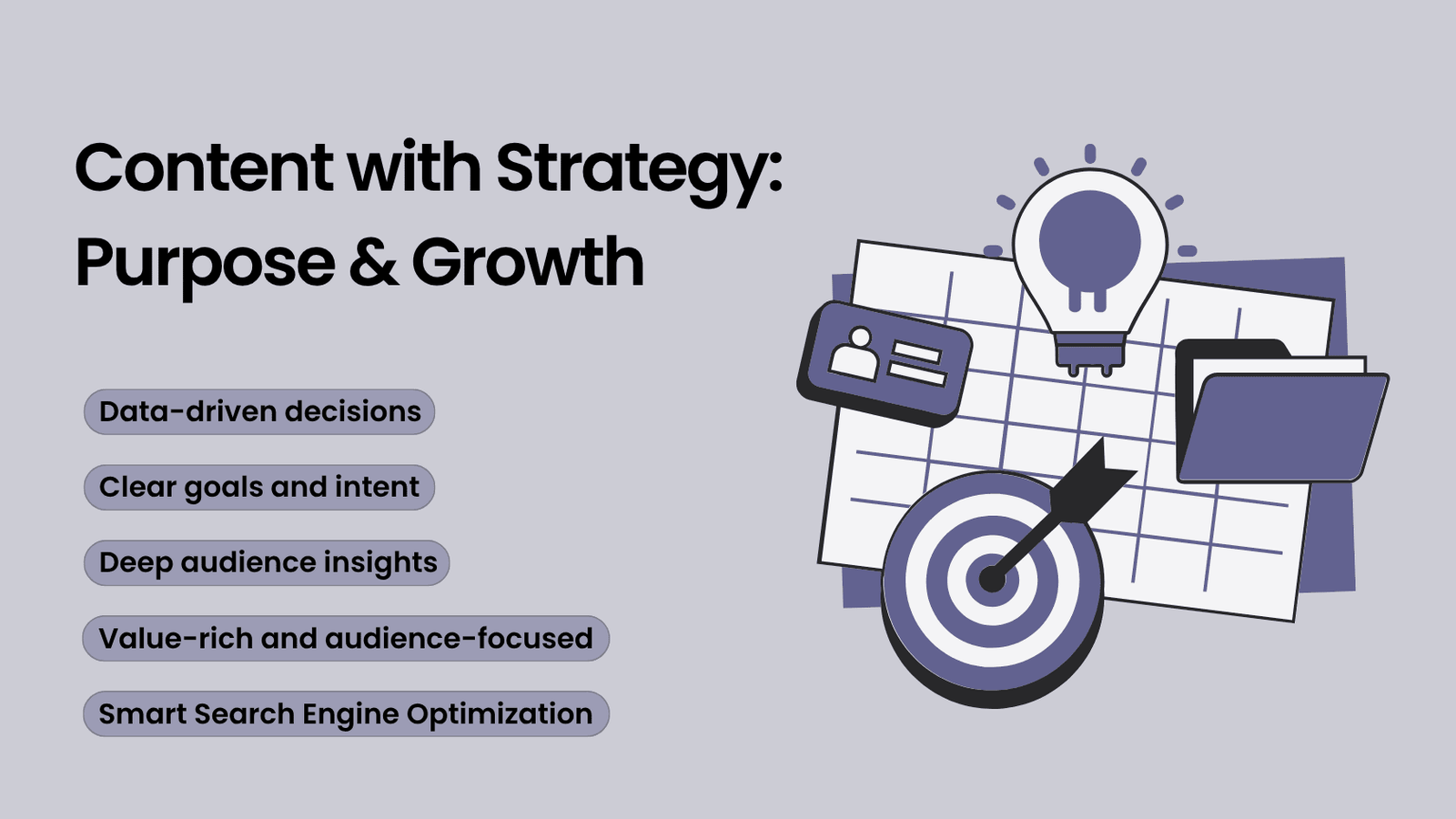Introduction
In today’s digital world, content is everywhere. Every brand posts, tweets, or blogs daily. But only a few truly grow — not because they produce more, but because they plan better. The secret? Content with strategy.
Without a strategy, content is noise. With strategy, it becomes purpose, and purpose fuels growth.
This blog dives deep into how aligning content with strategy creates measurable, lasting growth for your business.
1. Why Content Alone Isn’t Enough
For years, marketers repeated the phrase “Content is King.”
But that’s only half true.
Content without direction or intent gets lost in the digital noise.
You can create hundreds of posts or videos, but if they don’t align with your goals or your audience’s needs, they won’t convert. That’s where strategic content takes center stage.
A well-planned content strategy connects creativity with business goals. It ensures every piece of content:
- Has a clear objective
- Speaks to the right audience
- Leads toward a measurable outcome
Simply put, strategy turns content from busywork into a growth engine.
2. Understanding the Purpose Behind Your Content
Every great content strategy starts with one question: Why are we creating this?
Purpose is the foundation. It shapes the tone, style, and message.
There are many content purposes:
- Educate your audience
- Build brand trust
- Drive conversions
- Generate leads
- Retain customers
For example, if your goal is to educate, long-form blogs and tutorials make sense.
If you want conversions, landing pages and product videos are more effective.
Without identifying your purpose, even great content misses the mark.
3. How Strategy Fuels Growth
Content strategy goes beyond creation — it’s about distribution, optimization, and evolution.
A strong strategy:
- Defines your audience
- Chooses the right channels
- Aligns with business goals
- Uses data to refine performance
Growth happens when content works like a system — not a one-time effort.
When paired with Search Engine Optimization (SEO), content becomes visible to the right people at the right time. SEO ensures your strategy is sustainable — not just viral.
4. Building a Content Strategy That Drives Purpose
Here’s a simple framework that works across industries:
a. Define Clear Goals
Start with your business goals — awareness, traffic, or conversions.
Tie each content type to a goal.
b. Know Your Audience
Use analytics, surveys, and social insights to understand your audience’s behavior and preferences.
c. Choose the Right Channels
Whether it’s your blog, YouTube, LinkedIn, or email — focus on where your audience spends time.
d. Plan Consistent Messaging
Ensure your voice, tone, and brand values stay consistent across all platforms.
e. Measure Everything
Use tools like Google Analytics and Meta Insights to track engagement, traffic, and conversions.
That’s how Digital Marketing Agencies build campaigns that last — by connecting content with clarity and consistency.
5. The Power of Data-Driven Content
Strategy without data is guessing. Data shows what’s working — and what’s not.
Modern marketing tools allow you to:
- Track user intent and behavior
- Identify high-performing topics
- Optimize underperforming content
For instance, a business noticed that its “how-to” guides outperformed all other posts. They built a strategy focused on that format and tripled their organic traffic within months.
That’s growth backed by insight — not luck.
6. The Role of Storytelling in Strategic Content
Even with a solid strategy, emotion is what connects.
Storytelling bridges purpose and engagement.
It transforms data into relatable narratives that audiences remember.
Here’s the formula:
- Identify a problem
- Show the journey
- Offer a solution (your product or service)
Stories create trust. And trust drives action.
When combined with Social Media Marketing, storytelling amplifies your reach and turns engagement into relationships.
7. Aligning Strategy with Search Intent
Search intent is the new compass of digital growth.
Google’s algorithms now reward relevance over volume.
That’s why strategic content must align with what users actually search for — not just what brands want to say.
With regular Google Core Updates and the Helpful Content system, value-driven content ranks higher than keyword-stuffed articles.
Focus on human-first content that solves problems — not manipulates rankings.
This alignment is what keeps brands visible, trusted, and growing in the long term.
8. Real-World Example: Strategy in Action
Consider a SaaS startup that posted blogs weekly but saw minimal traffic.
After an audit, they realized they lacked content structure and SEO alignment.
They partnered with a Digital Marketing Agency to rebuild their strategy:
- Optimized their content calendar
- Used targeted keywords and clusters
- Distributed content through email and LinkedIn
Within 4 months:
- Organic traffic increased by 70%
- Lead quality improved
- Engagement rates doubled
The content didn’t change — the strategy did.
9. The Future of Content Strategy: AI + Human Insight
AI tools like ChatGPT, Jasper, and SurferSEO are transforming content creation.
But while AI improves efficiency, strategy ensures direction.
AI can help with:
- Keyword clustering
- Audience segmentation
- Predictive performance tracking
However, human insight is what keeps your message authentic.
The best marketers use AI for structure — not storytelling.
10. How to Keep Your Content Strategy Evolving
The digital world shifts fast. Algorithms, platforms, and audience behavior change constantly.
To stay ahead:
- Review analytics monthly
- Refresh old content with new data
- Experiment with emerging platforms
- Stay updated on Google’s algorithm and AI trends
Your content strategy should evolve with your audience — not against them.
Conclusion:
Content without strategy fades.
Strategy without purpose lacks soul.
But together, they create the perfect balance of creativity and clarity.
When your content aligns with business goals, data insights, and audience needs — growth becomes natural.In today’s marketing landscape, you don’t need more content.
You need content with strategy — because that’s what builds purpose, trust, and lasting growth.


